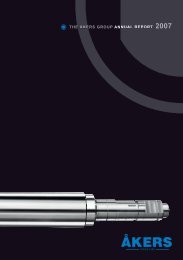CAEF Roll failures manual - The Åkers Group
CAEF Roll failures manual - The Åkers Group
CAEF Roll failures manual - The Åkers Group
You also want an ePaper? Increase the reach of your titles
YUMPU automatically turns print PDFs into web optimized ePapers that Google loves.
1.1 Saddle Spalls<br />
1.1.1 Description<br />
Section1 SPALLS<br />
<strong>The</strong>se are characteristic “saddle” shaped fatigue spalls originating in the core material<br />
below the shell/core interface and breaking out to the barrel surface. Variable intensity<br />
of fatigue lines may be seen in the deep areas of the spall indicating the propagation<br />
direction from the core to the barrel surface. <strong>The</strong>se spalls occur in work rolls with flake<br />
graphite iron core used in highly loaded 4-Hi hot mill stands and are predominantly<br />
located in the centre of the barrel.<br />
1.1.2 Origin<br />
Spalling is caused by high cyclic loads due to<br />
large reductions when rolling thin gauge and<br />
hard materials. <strong>The</strong>se loads induce high alternating<br />
stresses on the core material, beyond<br />
the fatigue limit, and many micro cracks begin<br />
to form causing a progressive weakening of<br />
the core material. In the second stage these<br />
micro cracks join together and propagate to<br />
and through the shell to the barrel surface<br />
giving rise to the large and typical “saddle”<br />
spall. High residual tensile stresses which were<br />
thermally induced in the core during manufacture<br />
will favour this type of roll damage. Long<br />
before the catastrophic spalling, the first stage<br />
of core weakening can easily be detected by<br />
ultrasonic testing. Reduction of the back-wall<br />
echo will indicate weakening of the core.<br />
<strong>The</strong> core material has insufficient fatigue<br />
strength to withstand the specific rolling loads.<br />
This is usually a roll fault.<br />
1.1.3 Remedy<br />
Correct information about rolling loads (t/m of strip width) and previous experience of<br />
roll <strong>failures</strong> should be advised to the roll supplier who will then specify a core material<br />
for the work rolls with higher strength properties appropriate for highly loaded mills (i.e.<br />
SG/Nodular Iron instead of lamellar/flake graphite cast iron.<br />
7




